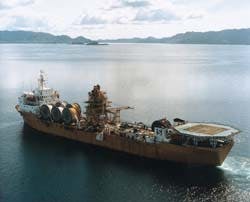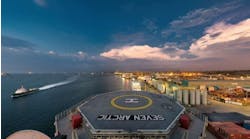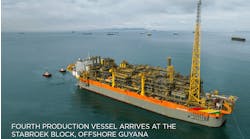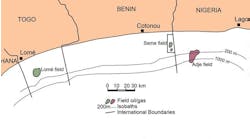Nick Terdre
Contributing Editor - Norway
Seaway Falcon has been converted for flexible pipelay dutiesIn the ever-changing world of offshore contractors where mergers, acquisitions and joint ventures are the order of the day, an alliance targeting subsea field development has been struck by Kvaerner and Stolt Comex Seaway (SCS).
The two groups have agreed to co-operate on specific projects where they can identify a role for their complementary services.
Together, the partners can offer a wide array of skills. Kvaerner brings to the party a wide range of seabed equipment such as wellheads and christmas trees, manifolds and protection structures, control systems and umbilicals, and remotely operated pull-in and connection systems.
SCS offers a fleet of offshore construction vessels, cable-lay and diving services, and is now adding a pipelay capability for rigid and flexible lines.
"Complimentary is the key word," says Per Gunnar Andersen, deputy head of Kvaerner Oil & Gas. "We have good products, and they have a substantial and efficient installation fleet."
The cooperation is organized in the form of regional working agreements. Kvaerner has appointed one of its companies to be the lead partner in each region - in Norway the designated company is Kvaerner Energy. SCS is a single company, so it has no need to follow suit.
For each project, a separate joint venture agreement will be drawn up. In each project, too, the contribution of each side may vary, according to the contracted work-scope.
"It will mainly be in the range of 60-40, but in some projects it could be 90-10," says Svein Ove Gjersdal, SCS's vice president, commercial, whose office looks out over the Stavanger Fjord to Kvaerner Rosenberg's massive fabrication shed on the other side.
SCS has looked for a partner before. Last year, it went a long way down the road to setting up an alliance with McDermott, only to call it off after months of preparatory work.
The partnership with Kvaerner has not yet won any jobs, but Gjersdal is happy with the way it is working. "The alliance has created a very good atmosphere between the two companies," he said. "We are indeed finding that our knowledge and experience are complementary."
He finds a ready example in the Seaway Falcon, the vessel which SCS has had converted to a flexible pipelay vessel - its maiden job this summer will be an extensive programme of flexible flowline and riser installation on Norsk Hydro's Troll Oil Field - with a reel-based rigid lay capability to be added for next season.
"If we invested in a pipelay vessel on our own, we would need to build up competence in pipeline design," he says. "Now we can go to Kvaerner."
One of the key attractions of the partnership for clients is its ability to offer full EPIC services. "Our decision to work together is partly market-driven," says Andersen. "The tendency today is towards turnkey contracts. Under these conditions, Kvaerner, as a supplier, may not get the opportunity to bid. And the same could be true of SCS."
"The advantage of giving the whole contract to us as a single entity is that we can take all aspects of the work into account early on and avoid duplication of non-value-adding activities, thus reducing costs," says Gjersdal.
"In a traditional project with several main contractors, there would be numerous intermediate penalty milestones at interface limits, often cast in stone several years ahead. Reducing the number of maincontractors, preferably to one, gives much more flexibility to meeting intermediate deadlines, which again enables us to act more cost-effectively."
The partners have worked together on various occasions in the past. One important reference is the Troll Oil project, on which SCS last year installed flexible flowlines and Kvaerner's new integrated steel tube umbilical.
In future projects it will use Kvaerner's new generation of pull-in and connection tools. This is the RTS - ROV-Operated Tie-In System - a much lighter and more easily manipulated package than its predecessors, which had to be deployed from a semisub.
Beyond subsea developments, there are other projects which the partners would be happy to tackle together, such as field abandonment, and the small wellhead platform developments which are becoming more common in the North Sea.
To such projects Kvaerner can bring its engineering expertise, its fabrication facilities and its offshore workforce.
Platform and module installation and removal can be carried out by SCS's Stanislav Yudin lift vessel, which is capable of lifting 2,000 tonnes.
Its fleet also includes, in addition to the Seaway Falcon, the semisubmersible construction vessel Amethyst, the diving-submersible support vessels Seaway Pelican, Seaway Harrier and Seaway Osprey, the survey and ROV support vessel Seaway Commander, and the Seaway Condor, a diving support vessel now converted into a cable and umbilical-lay vessel.
Copyright 1995 Offshore. All Rights Reserved.




